
City’s Creole cuisine is flavor of history
NEW ORLEANS— In the patois of New Orleans, a reference to the Holy Trinity calls to mind not the Christian deity, but instead the omnipresent triumvirate of chopped green peppers, onions and celery.
Here, in the Crescent City, food is a religion. And Creole food is the denomination of choice.
With its prodigious use of butter and cream, local seafood and heavy food with even heavier sauces, Creole cuisine is rich in both flavor and history.
The New Orleans Jazz National Park, established by Congress in 1994, encompasses most of the Vieux Carre, or French Quarter, of New Orleans.
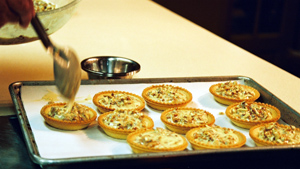 |
| Pecan pies are a big part of the Creole food tradition (Photos by Rachael Henrichsen). |
It celebrates Creole culture and food has great importance in Creole life. In kitchens and restaurants that line the Quarter’s narrow streets, locals and visitors alike congregate to worship gumbo, jambalaya and other staples of Creole cuisine with a fervor that can only be called Gourmania.
Creole, a French adaptation of the Spanish term criollo, is much misunderstood today, as the term meant different things in different historical periods. Creole was originally used in the 18th century to identify white and black people born in the colony of Louisiana, and to distinguish them from those who were born in Europe or Africa and later came to be in Louisiana.
Creole cuisine was born in New Orleans to the native-born children of immigrants, who adapted the recipes of their parents to the unique ingredients available in and around the swampy port city.
Gaetano “Tommy” DiGiovanni, executive chef at Arnaud’s, an elegant restaurant serving Creole cuisine at 813 Bienville St., since 1918, said that the city’s cosmopolitan history flavors the foods of the cuisine born here.
“No other cuisine has been born of so many nationalities,” said DiGiovanni, “A combination of spicy Spanish seasoning, Italian oils, the culinary art of the French provinces, of Paris and Marseilles, and the elegant artistry of aristocratic refugees from the French Revolution, mixed with the Native American influence and all stirred together with the skills of the African slaves.”
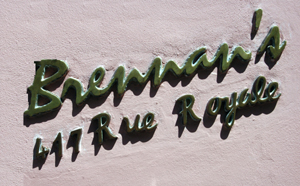 |
Executive Chef Michael Roussel of Brennan’s, 417 Royal St., one of the best known New Orleans restaurants, said that okra, a staple in Creole food, arrived in Louisiana tied in the hair of slaves imported from West Africa.
Upon arrival, the African women planted the seeds and grew okra, making an indelible impression of the taste of New Orleans.
Creole cuisine was also made possible by the location of the city. Deirdre Stanforth, born in New Orleans more than 80 years ago, is the author of a cookbook that collects recipes from area restaurants.
“The best produce came down the river to the mouth of the Mississippi from all of North America and up through the Gulf from South America and Mexico,” Stanforth said, “While seafood abounded in neighboring lakes and rivers and the woods were full of game.”
“Outside N’awlins, people are so used to following recipes step-by-step, and the food always comes out the same,” said Kevin Belton, owner of the New Orleans School of Cooking located at 524 St. Louis St., as well as the school’s head cooking instructor. “This place was nothing but swamps and bogs. The ingredients you found on one day may not have been available the next, so you make do with what you have.”
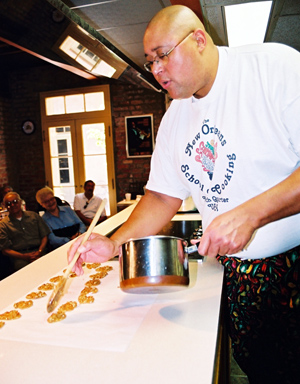 |
| Chef Kevin Belton demonstrates how to make pralines during a Creole cooking class in the French Quarter (Photo by Rachael Henrichsen). |
Malcolm Hébert, a New Orleans native and former food and wine editor for the San Jose Mercury News, agrees.
“There is one rule that both Creoles and Cajuns agree upon and that is there is no one rule and no one recipe when it comes to matters of food,” he said, “The Creole cook knows that everything they cook is original and authentic because their kitchens are kitchens of ‘ad-lib’.”
The no-rule rule does have one exception that both Hébert and Belton pointed out without the slightest hint of irony, and that is the recipe for Pralines. Pralines are a Creole confection made of nuts, milk, butter, sugar and vanilla.
The ingredients are combined and cooked to what is known as softball stage, where the mixture is cloudy and the nuts stay suspended in the pot. The mix is then spooned onto parchment or wax paper, where, if prepared properly, the pralines will harden and set. The recipe is inflexible because if the proportions of the ingredients are not correct, or if it is not cooked sufficiently, the candy will not harden.
Even this culinary catastrophe, when combined with Creole creativity, a bit of corn syrup, and poured over a heaping scoop of vanilla ice cream, can be renamed Praline Dessert Sauce, and no one would ever know the sauce was not intentional.
Visitors to Louisiana may at first confuse Creole with Cajun, but the two ethnic groups and their cuisines are quite different, both in history and flavors.
While the Creoles are descended from French, Spanish, and African emigrants, the Acadians, or Cajuns, are descended from a group of 1600 French Canadians whom the British forcibly removed from Nova Scotia in 1785, during the French and Indian War.
The Acadians, unlike the wealthier Creoles who aspired to the grand cuisines of Europe, were tough people used to living under tough conditions.
Both in Canada and then in Louisiana, the Acadians’ style of cooking was less refined and much easier to prepare.
Without the Creoles’ wealth, the Acadians did not generally have live-in cooks or slaves.
“The Acadians tended to serve strong country food prepared from locally available ingredients,” said Hébert, “It was pungent, peppery and practical since it was all cooked in a single pot.”
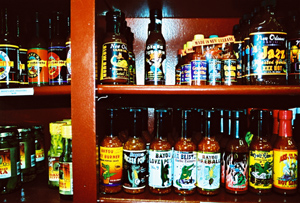 |
| Hot sauces are important ingredients in many Creole dishes (Photo by Rachael Henrichsen). |
Roussel said that to add to the confusion, Creole and Cajun foods often utilize some of the same ingredients, which makes sense seeing as the immediate availability of their ingredients was limited to roughly the same geographic area.
“Rice is a staple of both and Creole and Cajun chefs usually start a dish by making a roux of oil and flour,” he said.
Other ingredients likely to be found in both cuisines include crab, river shrimp, lake fish, oysters, crawfish, and all kinds of fowl, frogs, turtles, sausages, beans, yams and alcohol.
Stamford said that a quick but not foolproof test as to which of the two Louisiana cuisines a dish belongs is to look at the base ingredients.
“Usually but not always, Creole food will get its fat from cream, butter, and milk, while Cajun food relies on pork fat,” she said.
A nonscientific, side by side comparison of the menus from Arnaud’s, known for Creole food, and Kabby’s, located within the Hilton Hotel at 2 Poydras St., famous for Cajun, would suggest that Creole more often utilizes tomatoes as an ingredient, while Cajun food is spicier. They both seem to share the use of filé powder and, of course, the holy trinity.
Creole culture operated within a highly sophisticated plantation society, having roots in French, Spanish and French Colonial aristocracy. Revolving around winter social scenes in the city, and summer events at plantations, Creole society was populated largely by independent and well-to-do merchants, farmers, and other professionals who came to consider themselves a social aristocracy within Louisiana.
The need to distinguish those native-born from immigrants was maintained by the continuous immigration of Europeans, many of them aristocracy displaced by the revolutions in both France and Saint-Domingue (now known as Haiti) in the last decade of the 18th century. After the completion of the Louisiana Purchase in 1803, the term Creole was no longer applied to black people, as the importation of slaves to the area was banned by the U.S. Congress.
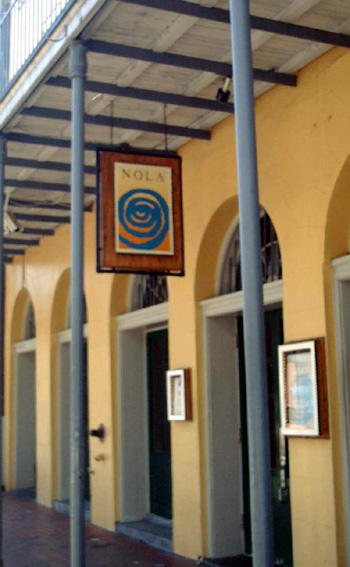 |
| The entrance to NOLA Restaurant (Photo by James Cohen). |
The Creole label for African-Americans was revived after the end of the Civil War by those black people who were already free even before the Emancipation Proclamation, in an attempt to proclaim a higher social status than those African-Americans freed by the war.
At this point, white Creoles abandoned their own Creole identity for fear of being confused with African-American Creoles.
In every mouthful of Creole cuisine can be tasted the history of the city of New Orleans.
In 1714, the first permanent European settlement in Louisiana was established by French settlers, and by the 1730s the area was a French crown colony that exported crops grown on plantations with the labor of African slaves.
In 1762, the colony was ceded to Spain in order to protect it from British attack during the hostilities of the French and Indian War. Spain attempted to make Louisiana less French and more Spanish, but largely failed, though the Spanish influence can be seen in the architecture of the French Quarter, rebuilt during this period after a fire. The Spanish too left their mark on the cuisine of New Orleans, with the introduction of a wide variety of spices imported from the Orient.
By 1800, the Spanish population of Louisiana had been all but absorbed into the French-speaking population, and the Spanish King returned Louisiana to the French, who sold the territory to the United States only three years later.
At only four cents an acre, the Louisiana Purchase was the largest land deal in history and such a bargain that the very thought of it must make Donald Trump’s toupee-hair stand up at attention.

Comments are Closed